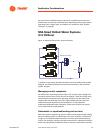
20 Chiller System Design and Control SYS-APM001-EN
Application Considerations
part of those jobs. See “Energy and economic analysis of alternatives” on
page 26.
Number of chillers
The number of chillers to install is a function of redundancy requirements
and first cost. In general, the more chillers installed, the higher the initial cost.
Therefore, many small systems only use one chiller. Most chillers in the 20
through 200 ton range use multiple compressors with multiple refrigeration
circuits and provide a reasonable level of cooling redundancy. The only
system controls installed on a single chiller installation may be a clock and
ambient lockout switch to enable and disable the chilled-water system. If only
one chiller is used, a system that varies the flow rate through the chiller can
be quite simple to operate. Minimum and maximum flows and maximum
rate of change for the flow would still need to be addressed (see “Variable-
Primary-Flow Systems” on page 55).
As systems get larger, the owner may require more redundancy, leading
them to install multiple chillers. Some designers use 200 tons as the
maximum job size for a single chiller.
When there is more than one chiller, there are many more system control
decisions to be made including:
• enabling the second chiller,
• turning the second chiller off, and
• failure recovery.
Two-chiller plants require higher system control intelligence than single
chiller plants. Sequencing logic, discussed in “System Configurations” on
page 42, varies based on system configuration, and failure recovery is
discussed on page 95.
Parallel or series
Parallel configurations are more common than series configurations. (See
“Parallel Chillers” on page 42.) In chiller systems with an even number of
chillers, there are advantages to putting them into a series configuration,
especially if low or variable water flow is desired. This offers the benefits of
better system efficiency and higher capacity because the upstream chiller
produces water at a warmer temperature. Series chillers should not be
applied with low system Ts, because the maximum flow through the chillers
may be reached. Efforts to eliminate the so-called “Low T syndrome” (page
79) must be addressed for both configurations. The energy and control
requirements of series chillers are covered in “Series Chillers” on page 44.
Part load system operation
For small chilled-water systems, especially those with only one chiller, part
load system energy use may be dominated by ancillary equipment,
especially in a constant flow system. At low loads, constant speed pumps
and tower fans constitute a much larger portion of the chiller plant energy


















